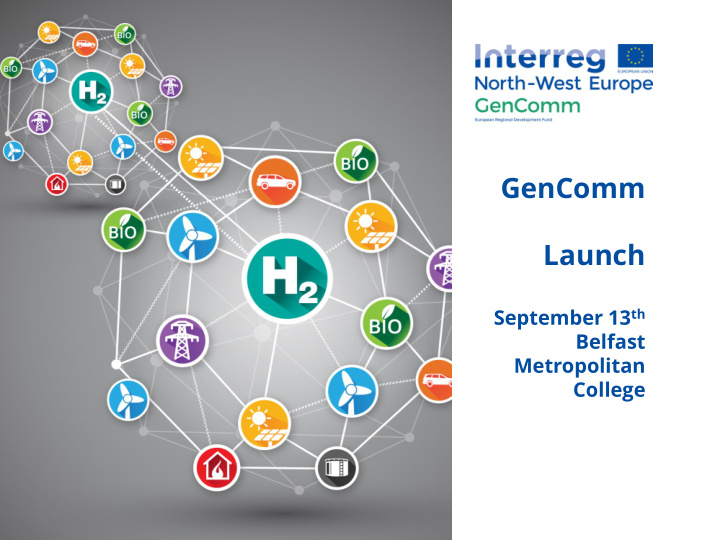



GenComm Place image in this area. Launch September 13 th Belfast Metropolitan College
Key Note Speaker Dr Michel Junker Hydrogen as an Energy Carrier
Actual tr trend An « urgent » » ch change in in th the energy market is is needed World energy consumtption Very high growth of worldwide population - 8,4 bil. in 2030 vs 6,9 bil. en 2010 Growth of energy consumption - Necessary to maintain the level of comfort and development Climate Change - Increase of GHG emissions - Increasing temperature Need to reduce the CO 2 and CH 4 emissions On-site industrial H2 - Reduction of GHG emissions from industry « Hydrogen mobility » - Reduction of GHG emissions in the transport sector « Hydrogen energy » – Power-to-Gas - Increasing the rewable energy production H2 as an energy carrier - Decouple energy production from energy emissions
Hydrogen: Ess ssentia ial l tod oday Ess ssentia ial l tomorow Massively used as raw material for industry Produced / transported / used since more than 100 years 60 Mio. T / year = 29 billion € market (non energy puposes) An unlimitted ressource: most abundant element on earth in hydrocarbons, specialy in methane (CH 4 ) Mostly in water (H 2 O) A high energy content Fuel for space engines 1 kg H2 = 33 kWh ( about 3 times the energy content of conventional fuels) 1 kg H2 = more than 100 km when used in a fuel cell car
A ch change of f paradigm in in th the energy model Reforming Natural gas PV Electrolysis Mobility H2 fuel FC vehicle Variable Biomass Wind production Energy Electricity - heat Gas storage - grid Grid Gas turbine Nuclear + Fossil Industry Inustrial use Methanation of H2 Constant CO2 use / others Industry production
Rec ecover surp surplus ren enewable le en energie ies En Energy Stor orage Re Re-electrif ific icatio ion Limits of today’s renewable technologies Worldwide increase of Non regular production Electricity production Grid saturation Coal Natural gas Nuclear Hydroelectricity Not predictable Renewable Liquids The production of renewable energies in the energy mix requires to value these surpluses and therefore depends on the smoothing and storage of production
Hydrogen is the most suitable technology for the mass storage over a long duration (1) Superconduction Magnetic Energy Storage
Hydrogen mobili ility is is gain ainin ing momentum glo loball lly World HRS network H2 FCEV are About 400 vs > 230 000 gasoline stations ready for the road (Europe, US, Japan, South-Corea) Investment per HRS Depending on capacity, delivery pressure and if there is on-site production - 0,2 – 2 Mio. € Forecast HRS Forecast HRS GB Germany Actual Actual
Hy Hydrogen an and batteries : : com omplementary technologies for or car arbon fr free ee el electromobility European road transport ~ 17 % of total CO 2 emissions Neccessary reduction of 95 % Vehicles fueled with renewable H2 are carbon-free and have the same advantages as conventional vehicles Batteries Range: 120 – 400 km « refuelling »: 1/2 to 8 hr For urban use Fuel Cell Range: 500 – 600 km « refuelling »: 3 to 5 min, < 50 € Range For any vehicle type
Example of building a deployment strategy « H 2 Mobilité France »
H2 from renewables, through water electrolysis offers the opportunity to integrate renewable generation as well as smooth the loading factor of nuclear plants; - - to be used as energy carrier for different applications (on-site electricity, heat & transport); To decarbonise other sectors by injection into the gas grid = combination with CO 2 to - produce synthetic methane or higher HC’s
SMR: Steam Methane Reforming Hydrogen production supports integration of high proportion of renewable electricity into the grid and offers opportunities to develop new business models in the energy sector
(France)
in the early years of deployment
• On-site hydrogen production through electrolysis (renewable electricity) is an opition in the first the first deployment projects Car sharing initiatives
Hig igher ope operati ting tim time com ompared with ith ba battery el electri ric veh ehicl cles
Flexible usage of H2 can help reduce the duration of the VOD (phase 2) by generating additional revenues for the HRS operator
€ /kg Time (years)
Any questions? Thank You 13/9/2017 25
Recommend
More recommend